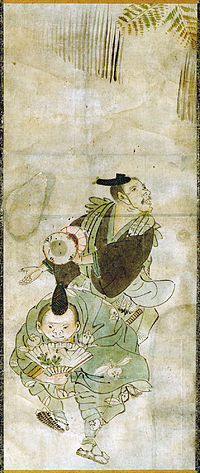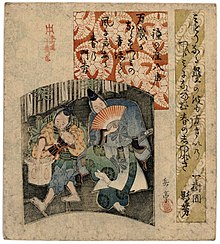Manzai

Manzai(Mạn tài)is a traditional style of comedy inJapanese culturecomparable todouble actcomedy.[1]
Manzaiusually involves two performers (manzaishi)—astraight man(tsukkomi) and afunny man(boke)—tradingjokesat great speed. Most of the jokes revolve around mutual misunderstandings,double-talk,punsand other verbal gags.
In recent times,manzaihas often been associated with theOsakaregion, andmanzaicomedians often speak in theKansai dialectduring their acts.
In 1933,Yoshimoto Kogyo,a large entertainment conglomerate based in Osaka, introduced Osaka-stylemanzaitoTokyoaudiences and coined the term "Mạn tài"(one of several ways of writing the wordmanzaiin Japanese; see§ Etymologybelow). In 2015, Matayoshi Naoki's manzai novel,Spark(Hỏa hoa),won theAkutagawa Prize.[2]A mini-series adaptation was released on Netflix in 2016.
History[edit]
Originally based around a festival to welcome theNew Year,manzaitraces its origins back to theHeian period.The twomanzaiperformers came with messages from thekamiand this was worked into a standup routine, with one performer showing some sort of opposition to the word of the other. This pattern still exists in the roles of thebokeand thetsukkomi.

Continuing into theEdo period,the style focused increasingly on the humor aspects of stand-up, and various regions of Japan developed their own unique styles ofmanzai,such asOwari manzai(Vĩ trương vạn tuế),Mikawa manzai(Tam hà vạn tuế),andYamato manzai(Đại hòa vạn tuế).With the arrival of theMeiji period,Osaka manzai(Đại phản vạn tài)began to implement changes that would see it surpass in popularity the styles of the former period, although at the timerakugowas still considered the more popular form of entertainment.
With the end of theTaishō period,Yoshimoto Kōgyō—which itself was founded at the beginning of the era, in 1912—introduced a new style ofmanzailacking much of the celebration that had accompanied it in the past. This new style proved successful and spread all over Japan, including Tokyo. Riding on the waves of new communication technology,manzaiquickly spread through the mediums ofstage,radio,and eventually,television,andvideo games.[3][4][5][6][7]
Etymology[edit]
Thekanjiformanzaihave been written in various ways throughout the ages. It was originally written as lit. "ten thousand years"orbanzai,meaning something like "long life"(Vạn tuế),usingVạnrather than the alternative form of the character,Vạn,and the simpler formTàiforTuế(which also can be used to write a word meaning "talent, ability" ). The arrival ofOsaka manzaibrought another character change, this time changing the first character toMạn.
Bokeandtsukkomi[edit]
Similar in execution to the concepts of "funny man" and "straight man"indouble actcomedy (e.g.Abbott and Costello), these roles are a very important characteristic ofmanzai.Boke(ボケ)comes from the verbbokeru(Hốt ける/ ngốc ける)which carries the meaning of "senility" or "air headed-ness" and is reflected in theboke's tendency for misinterpretation and forgetfulness. The wordtsukkomi(Đột っ込み)refers to the role the second comedian plays in "butting in" and correcting theboke's errors. In performances it is common for thetsukkomito berate thebokeand hit them on the head with a swift smack; one traditionalmanzaiprop often used for this purpose is a pleated paper fan called aharisen(Trương り phiến).[8]Another traditionalmanzaiprop is a small drum, usually carried (and used) by theboke.A Japanese bamboo and paper umbrella is another common prop. These props are usually used only during non-seriousmanzairoutines as traditionalmanzairequires there to be no props in terms of routine and in competitions. The use of props would put the comedy act closer to aconterather thanmanzai.
The tradition oftsukkomiandbokeis often used in otherJapanese comedy,although it may not be as obviously portrayed as it usually is inmanzai.[citation needed]
-
Hanabishi Achako and Yokoyama Entatsu established the talk show-centeredmanzaistyle. They were active since 1919.
-
"All Hanshin-Kyojin", active since 1975
-
"Wagyu", active since 2006.Manzaiactors often work as multi-talents.
Notablemanzaiacts[edit]
- Downtown
- Cocorico
- Takeshi Kitano;Japanese film director, television host, and formermanzaiperformer in the group "Two Beat".Manzaiis mentioned and referenced in a number of his other works.
- Gen Takagi
Literary associations[edit]
- Kikakuwrote with affectionate mockery ahaikuon themanzaidancers: "The New Year Dancers / Never miss a single gate – / Millet for the crane".[9]
- Busonmore positively wrote: "Yes, New Year's dancers – / Pounding good and properly, / The dirt in Kyoto".[10]
See also[edit]
- The Manzai Comics– manga series about a young manzai duo
- Double act
- Nininbaori
- Kyōgen
- Rakugo
- Owarai
- Xiangsheng– the Chinese analogue tomanzai.
- Spark(Hỏa hoa)– a 2015 novel about twomanzaiartists
- Hibana (Spark)– a 2016Netflixseries adapted from the novelSpark
- M-1 Grand Prix– the most prevalentmanzaicompetition in Japan
References[edit]
- ^Blair, Gavin (2016)."What's Manzai?".Highlighting Japan June 2017.Public Relations Office of the Government of Japan.Retrieved4 November2019.
- ^Kyodo, Jiji (17 July 2015)."Comedian Matayoshi's literary win offers hope for sagging publishing industry".The Japan Times.Archivedfrom the original on 27 August 2015.
- ^Hiragana lesson through Japanese culture – manzai
- ^Manzai (Double-act comedy)
- ^Japanese yose theater – Japanese comedy showsArchived3 November 2007 at theWayback Machine
- ^Corkill, Edan, "Yoshimoto Kogyo play reveals manzai's U.S. roots",Japan Times,25 May 2012, p. 13
- ^Ashcraft, Brian, "Ni no Kuni’s Funny Bone Has Quite the History",Kotaku,5 October 2011
- ^WWWJDICArchived3 January 2015 at theWayback Machine
- ^L Zolbrod,Haiku Painting(1982) p. 16
- ^L Zolbrod,Haiku Painting(1982) p. 16
External links[edit]
- What is Manzai2015 archive
- "Commodified Comedians and Mediatized Manzai: Osakan Comic Duos and Their Audience"by Xavier Benjamin Bensky. A study in the cultural effects ofmanzai.



